An 18-million-year-old fossil tooth points towards a tiny primate no heavier than a hamster.
The lonesome tooth was found in Peru’s Amazon jungle by a team of Peruvian and American scientists from an exposed river bank along the Río Alto Madre de Dios. A single upper molar, the specimen was just “double the size of the head of a pin” and “could fall through a window screen,” said first author Richard Kay, a professor of evolutionary anthropology at Duke University.
Tiniest monkey
“Primate fossils are as rare as hen’s teeth,” said Kay, who has been doing paleontological research in South America for nearly four decades.
The team found the tooth after sorting through roughly 2,000 pounds of sandstone and gravel collected along the Río Alto Madre de Dios. They report finding hundreds of fossils of rodents, bats, and other animals — but a single monkey tooth. Luckily, it was a molar.
Paleontologists can tell a lot from primate teeth, but molars are particularly telling. Judging from its shape and size, the authors estimate that the animal likely had a diet heavy on fruits and insects, and weighed under half a pound. Some of the larger monkeys in South America today can grow to over 50 times that weight. The team dubbed the animal Parvimico materdei, or “tiny monkey from the Mother of God River.”
“It’s by far the smallest fossil monkey that’s ever been found worldwide,” Kay said.
But, its diminutive size isn’t the only thing that sets this tooth apart. It’s also one of the precious few clues scientists have from a missing chapter in monkey evolution. Primates are believed to have arrived in South America some 40 million years ago from Africa, and quickly diversifying into the 150-plus New World species we know today. The details of how that process unfolded is a bit of a mystery, however, in large part due to a gap in the fossil record (for primates in the area) between 13 and 31 million years ago. Parvimico lies comfortably in that gap.
The new fossil is aged between 17 to 19 million years, “smack dab in the time and place when we would have expected diversification to have occurred in the New World monkeys,” Kay said.
The tooth is now housed in the permanent collections of the Institute of Paleontology at Peru’s National University of Piura. The team is currently on another fossil collecting expedition in the Peruvian Amazon until August, concentrating their efforts in remote river sites with 30-million-year-old sediments. They hope to find more primate fossils.
The paper “Parvimico materdei gen. et sp. nov.: A new platyrrhine from the Early Miocene of the Amazon Basin, Peru” has been published in the Journal of Human Evolution.










